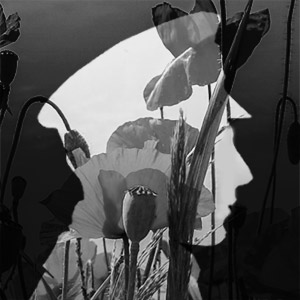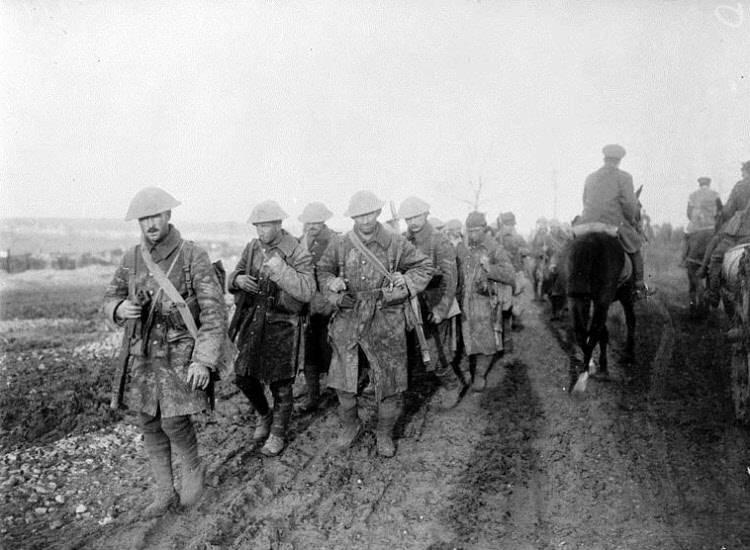
George Rowland Coulson was born in Wakefield on the 7th November 1882, the son of Cambridgeshire-born couple Samuel Coulson and his wife, Susan Ann (nee Gee), who married in 1869 and moved to live in Alverthorpe in the mid/late 1870s.He was baptised at St Michael’s Church Westgate Wakefield on 5th January 1883. George was the seventh child, and seventh son, of nine children born to the couple. His father, Samuel, worked as a maltster and all of the couple’s children were born in the Wakefield area.
In May 1899, George Rowland Coulson appeared before the Justices in March, Cambridgeshire, his parents’ former home town. He was charged with using obscene language in Town-end, March on 26th ult. Defendant, who was described by the superintendant of police as “the terror of the Town-end”, was fined 5s and 12s costs, or 14 days in default. This may not have been George’s first brush with the law. It certainly was not to be his last.
On the 27th June 1899 at the age of 17 years and 7 months, George Rowland Coulson, then a labourer living at Westgate Common, Wakefield attested at Cambridge to join the Militia and became a soldier, service number 7064, in the 3rd battalion, Kings Own Yorkshire Light Infantry (KOYLI). Throughout his life, George had trouble with his age, always claiming to be one year older than he was. In answer to the Attestation question regarding previous convictions, George, confirmed that he had none. On the 22nd November 1899, after 49 days in army service, he appears to have been transferred to KOYLI Reserve.
In July 1908, 25 year-old George Coulson married Maud Mary Graham at St Michael’s Church,Wakefield. By the 2nd April 1911, George Coulson, his wife, Maud, and their 3 year-old daughter Audrey were living at 31, Manor Road, Ossett, which was the home of Maud’s parents Henry Hanson Graham and his wife Dinah, who had fourteen children, seven of whom had died before April 1911.
On 15th September 1909 the “Yorkshire Evening Post” reported this story concerning Coulson:
“HUSBAND ASLEEP ON THE SOFA – At Wakefield City Court, this morning, an extraordinary story was told during the hearing of a charge of aggravated assault preferred against George Rowland Coulson, labourer, Hallilay Row, Westgate Common. The evidence showed that on Saturday night Coulson went to the house of James Lord, in Chald Lane after 11 o’clock, and asked if he might come in and bring a large stone bottle of beer to drink. Permission was given and prisoner and another man, named Lowrie, came in and they and Lord drank the beer, with the result that the latter fell asleep on the sofa, and knew nothing more until about 8 o‘clock the following morning, when he found his wife in a pitiable condition, her face being one mass of bruises. There were also severe injuries on her body.
The woman’s statement was to the effect that, after Lowrie had left at midnight, her husband fell asleep and prisoner then knocked her down and committed an aggravated assault. The woman’s face bore signs of the assault and she was in a very weak state.
In committing prisoner to gaol for six months, the Mayor said: You are what we should call a brute; nothing more nor less. If we could deal with you as men we should not send you to prison, but should treat you differently. Prisoner was ordered to pay the costs £1 17s 6d, or a further month’s imprisonment in default.”
George Rowland Coulson wasn’t yet finished with the British judiciary and on the 4th March 1913, he was sentenced at Leeds Assizes to six months with hard labour. By this time Coulson was 32 years of age and a stoker. He was indicted for breaking into his mother’s house at Wakefield and stealing various articles of jewellery on the 22nd February 1913.
The Calendar of Prisoners tried at the Winter Assizes 1913 records that Coulson pleaded guilty to the offence of “burglariously breaking into and entering the house of Susan Ann Coulson and stealing therein a gold watch, a gold chain, two gold rings, a gold brooch and other articles the property of the said Susan Ann Coulson at Wakefield on the night of the 22nd February 1913.”
The calendar also records his offence of assault in 1909 and another, unspecified, incident on 14th February 1912 on enclosed premises for which he received 2 months imprisonment. He had also been once fined for gaming.
Between late 1913, following his sentence, and October 1915, George emigrated to Canada. It is not known if he was alone or accompanied by his wife and child, but on enlistment he gave his wife’s address in Ossett. In the light of the earlier incidents in his life it seems likely that he sailed alone. On the 12th October 1915, at Montreal, George enlisted in the Canadian Army and joined the 73rd Battalion with the service number 132893. He gave his birth date, wrongly, as 7th November 1883 (it was 1882) and his wife’s name as his next-of-kin at her address of 32, Manor Road, Ossett, Yorkshire. He was 5’7¼” tall with a fair complexion, brown eyes and light brown hair. His occupation was given as barber and he indicated that he had previously served in the K.O.Y.L.I.
George’s enlistment in the Canadian Army in October 1915 appears to have been annulled for some reason, but he enlisted for a second time at Montreal on the 7th December 1915, this time giving his name as Thomas Atkins. This was the generic name applied to British Army soldiers, “Tommies”, for many years. As such it was, perhaps, not the most convincing alias but it does appear to have enabled him to remain in the Canadian Expeditionary Force with the service number 121511. He gave his birthplace as near York, Yorkshire and his next of kin as Samuel Atkins of 25 McImpress St., Yorkshire. He gave his age as 32 years and one month when he enlisted in the 69th Battalion and he was 5’ 7” tall, 145 lbs weight with a fair complexion, brown eyes and grey hair, with tattoos on both forearms. In comparison with his first, abortive, enlistment he had lost ¼” in height and his hair had turned from light brown to grey. His attestation papers indicate that at some stage, possibly after his death, the Canadian authorities became aware of the circumstances and the papers indicate that Thomas Atkins was “alias George Coulson”.
George enlisted, for the second time, this time in the 69th Battalion but shortly afterwards he was transferred to the 60th Battalion Canadian Infantry, known as the Victoria Rifles of Canada. The 60th Battalion recruited in and was mobilised at Montreal. It was authorised on the 20th April 1915 and embarked for Great Britain on the 4th November 1915. George did not successfully enlist until the 7th December 1915, but it is possible that he was with the 60th Battalion when it disembarked in France on the 21st February 1916. Whilst serving with them he was injured and died of his wounds, (gunshot wounds head & lung) at No. 1, Australian General Hospital at Rouen, France on the 1st October 1916.
The 60th Battalion Canadian Expeditionary Force (CEF) fought in France as part of the 9th Infantry Brigade in the 3rd Canadian Division. This Division fought at the Battle of Mont Sorrel (aka Battle of Hill 60) near Ypres, Belgium in June 1916. The Division then moved to the Somme, France and prior to George’s death it fought in the Battles of the Somme at Flers-Courcelette, Morval and Thiepval in mid/late September 1916 and the Battles of Le Transloy and the Ancre Heights in early October 1916. It is likely that George Rowland Coulson died of wounds incurred at one of these late September 1916 actions.

Above: Canadian soldiers at the Somme in late 1916.
George Rowland Coulson is not remembered on any Ossett Memorial or Roll of Honour in spite of him living in the town in 1911. Indeed, it may be that he lived in Ossett between his marriage in 1908 and his emigration to Canada sometime before 1915. Whilst no record of a medal award can be traced, George qualified for the same campaign medals as his British Amy compatriots. As such he was entitled to the British and Victory medals. Because he enlisted in December 1915 it is unlikely that he served overseas before the 31st December 1915 and consequently he would not have qualified for the 1914/15 Star.
He is remembered in this 2014/2016 biography and Roll of Honour because the Commonwealth War Graves Commission and/or the U.K. Soldiers who Died in the Great War 1914-1918 listing records him as born or residing in Ossett. He is also remembered on the Canadian Virtual War Memorial.
Private George R. Coulson, son of Samuel and Susan Coulson; husband of Maud M. Coulson, of 31, Manor Rd., Ossett. Native of March, Cambs died aged 33 years on the 1st October 1916 and is buried at grave reference B.22. 22. at the St. Sever Cemetery,1 Rouen, France. St Sever Cemetery and St Sever Cemetery Extension are located within a large communal cemetery situated on the eastern edge of the southern Rouen suburbs of Le Grand Quevilly and Le Petit Quevilly.
During the First World War, Commonwealth camps and hospitals were stationed on the southern outskirts of Rouen. A base supply depot and the 3rd Echelon of General Headquarters were also established in the city.
Almost all of the hospitals at Rouen remained there for practically the whole of the war. They included eight general, five stationary, one British Red Cross, one labour hospital, and No. 2 Convalescent Depot. A number of the dead from these hospitals were buried in other cemeteries, but the great majority were taken to the city cemetery of St. Sever. In September 1916, it was found necessary to begin an extension.
St. Sever Cemetery contains 3,082 Commonwealth burials of the First World War. There is also 1 French burial and 1 non war service burial here.
References: